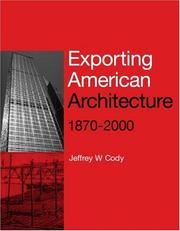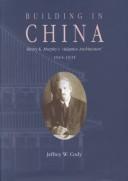| Listing 1 - 9 of 9 |
Sort by
|

ISBN: 1135804885 1280114088 020398658X 9780203986585 9780419246909 0419246908 0419246908 9781135804886 9781135804831 1135804834 9781135804879 1135804877 9780415299152 0415299152 Year: 2003 Publisher: London New York Routledge
Abstract | Keywords | Export | Availability | Bookmark
 Loading...
Loading...Choose an application
- Reference Manager
- EndNote
- RefWorks (Direct export to RefWorks)
The export of American architecture began in the nineteenth century as a disjointed set of personal adventures and commercial initiatives. It continues today alongside the transfer of other aspects of American life and culture to most regions of the world. Jeffrey Cody explains how, why and where American architects, planners, building contractors and other actors have marketed American architecture overseas. In so doing he provides a historical perspective on the diffusion of American building technologies, architectural standards, construction methods and planning paradigms.
Architecture, Modern --- Architecture, American. --- American architecture --- Architecture --- History --- Architecture, American --- Architecture américaine --- Histoire

ISBN: 9622018718 Year: 2001 Publisher: Hong Kong Seattle Chinese university press University of Washington Press
Abstract | Keywords | Export | Availability | Bookmark
 Loading...
Loading...Choose an application
- Reference Manager
- EndNote
- RefWorks (Direct export to RefWorks)
Architecture, American --- Architecture --- History --- Murphy, Henry Killam,
Book
ISBN: 9781606060544 1606060546 Year: 2011 Publisher: Los Angeles Getty Research Institute
Abstract | Keywords | Export | Availability | Bookmark
 Loading...
Loading...Choose an application
- Reference Manager
- EndNote
- RefWorks (Direct export to RefWorks)
Uncovered here is a captivating visual history of China during photography's first century. Chinese export painters learned and adapted the medium of photography by grafting the new technology onto traditional artistic conventions - employing both brush and shutter. The essays in this volume shed light on the birth of a medium.
S04/0705 --- S17/2010 --- S17/2125 --- China: History--Modern history, China: after 1840 --- China: Art and archaeology--Photography --- China: Art and archaeology--Musea and exhibitions: USA --- Exhibitions --- Photography, Artistic --- Photography --- China --- History --- Social aspects
Book
ISBN: 9781606065938 1606065939 Year: 2019 Publisher: Los Angeles, CA : Getty Conservation Institute,
Abstract | Keywords | Export | Availability | Bookmark
 Loading...
Loading...Choose an application
- Reference Manager
- EndNote
- RefWorks (Direct export to RefWorks)
This book, the eighth in the Getty Conservation Institute's Readings in Conservation series, fills a significant gap in the published literature on urban conservation. This topic is distinct from both heritage conservation and urban planning; despite the recent growth of urbanism worldwide, no single volume has presented a comprehensive selection of these important writings until now.This anthology, profusely illustrated throughout, is organized into eight parts, covering such subjects as geographic diversity, reactions to the transformation of traditional cities, reading the historic city, the search for contextual continuities, the search for values, and the challenges of sustainability. With more than sixty-five texts, ranging from early polemics by Victor Hugo and John Ruskin to a generous selection of recent scholarship, this book thoroughly addresses regions around the globe. Each reading is introduced by short prefatory remarks explaining the rationale for its selection and the principal matters covered.
Historic preservation. --- Historic sites --- Cities and towns --- City planning. --- Conservation and restoration --- Conservation and restoration. --- Historic preservation --- City planning --- Civic planning --- Land use, Urban --- Model cities --- Redevelopment, Urban --- Slum clearance --- Town planning --- Urban design --- Urban development --- Urban planning --- Land use --- Planning --- Art, Municipal --- Civic improvement --- Regional planning --- Urban policy --- Urban renewal --- Global cities --- Municipalities --- Towns --- Urban areas --- Urban systems --- Human settlements --- Sociology, Urban --- Preservation, Historic --- Preservationism (Historic preservation) --- Cultural property --- Government policy --- Management --- Protection --- City Planning --- Architecture --- Quartiers anciens --- Conservation et restauration.
Book
ISBN: 9780824834562 9789888028719 Year: 2011 Publisher: Honolulu University of Hawai'i press
Abstract | Keywords | Export | Availability | Bookmark
 Loading...
Loading...Choose an application
- Reference Manager
- EndNote
- RefWorks (Direct export to RefWorks)
S17/1610 --- 72.01 <51> --- China: Art and archaeology--Civil architecture --- Architectuurtheorie. Bouwprincipes. Esthetica van de bouwkunst. Filosofie van de bouwkunst--China --- Architecture --- Eclecticism in architecture --- Beaux-Arts architecture --- Beaux-Arts design --- Architecture, Modern --- Architecture, Western (Western countries) --- Building design --- Buildings --- Construction --- Western architecture (Western countries) --- Art --- Building --- Western influences --- History --- Design and construction --- Architecture, Primitive
Book

ISBN: 2859448225 2859444912 Year: 2015 Publisher: Paris : Éditions de la Sorbonne,
Abstract | Keywords | Export | Availability | Bookmark
 Loading...
Loading...Choose an application
- Reference Manager
- EndNote
- RefWorks (Direct export to RefWorks)
En Asie, le grand hôtel est directement lié au voyageur étranger. Il correspond à un temps non seulement de modernisation urbaine mais aussi d'ouverture et de relation avec les Occidentaux. C'est donc un lieu de rapport de forces économiques, d'importation de techniques modernes et de comportements nouveaux, un lieu enfin de confrontation culturelle. Objet urbain importé de l'Occident, le grand hôtel s'impose néanmoins comme marqueur des sociétés urbaines asiatiques. Il invite ainsi à reconsidérer les oppositions classiques entre la tradition et la modernité, l'identité asiatique et l'occidentalisation. Différentes générations de grands hôtels coexistent aujourd'hui dans les métropoles développées d'Asie que sont Tôkyô, Séoul, Hong Kong, Shanghai ou Pékin. Nombreux sont leurs atouts pour attirer les clients locaux et étrangers : ils s'appuient sur l'évocation de temps magnifiés et révolus, ou au contraire sur la modernité et le renouveau qu'ils incarnent ; ou bien ils jouent de leur double identité occidentale et asiatique ; enfin, ils offrent des services spécifiques (bar de nuit, salle d'exposition, centre de conférence…). Deux démarches sont ici suivies : une comparaison de l'usage asiatique du grand hôtel – et de ses temporalités – avec celui en Europe et en Amérique du Nord ; puis, l'analyse des modèles urbains venus d'Occident non pas sous l'angle de la seule importation mais aussi sous celui d'une histoire proprement asiatique de l'occidentalisation. À partir d'un objet singulier, cet ouvrage propose une interrogation sur la ville dans ses dimensions spatiale, sociale et de représentation. Il porte en particulier sur les sociabilités urbaines en Asie aujourd'hui, et il est issu d'une réflexion commune entre architectes, historiens et géographes, tous spécialistes de l'Asie orientale.
Hotels --- City planning --- Hôtels --- Planification urbaine --- Social aspects --- Aspect social --- Social aspects. --- Hotels, taverns, etc. --- Inns --- Hospitality industry --- Boardinghouses --- Taverns (Inns) --- Asie --- palaces --- hôtels
Book
ISBN: 160606875X 160606875X 9781606068755 9781606068755 Year: 2024 Publisher: Los Angeles: Getty Conservation Institute,
Abstract | Keywords | Export | Availability | Bookmark
 Loading...
Loading...Choose an application
- Reference Manager
- EndNote
- RefWorks (Direct export to RefWorks)
The Italian architect, historian, and restorer Gustavo Giovannoni (1873-1947) was a key figure in the fields of architecture, urbanism, and conservation during the first half of the twentieth century. A traditionalist largely neglected by the proponents of modernist architecture following World War II, he remains little known internationally. His writings, however, represent a significant step toward the full appreciation of the historic city and are directly relevant today to the protection of urban historic resources worldwide. This abundantly illustrated critical anthology is a representative sample of Giovannoni's seminal texts related to the appreciation, understanding, and planning of historic cities. The thirty readings, which appear with their original illustrations, are grouped into six parts organized around key concepts in Giovannoni's conservation theory-urban building, respect for the setting or context, a thinning out of the urban fabric, conservation and restoration treatments, the grafting of the new upon the old, and reconstruction. Each part is preceded by an introduction, and each individual reading is prefaced by succinct remarks explaining the rationale for its selection and the principal matters covered. Six plate sections further illustrate the readings' main concepts and themes. This long-awaited translation of Gustavo Giovannoni's writings marks a significant milestone in conservation literature. It was through Giovannoni's innovative ideas and hands-on experiments that the pursuit of urban conservation emerged in the early twentieth century; his work became the foundation upon which contemporary architectural restoration theory was laid.
Patrimoine architectural --- Monuments --- Centre historique --- Quartier ancien --- Rénovation des bâtiments --- Rénovation urbaine --- Planification urbaine --- Protection du patrimoine
Book

ISBN: 9780824861018 Year: 2011 Publisher: Honolulu
Abstract | Keywords | Export | Availability | Bookmark
 Loading...
Loading...Choose an application
- Reference Manager
- EndNote
- RefWorks (Direct export to RefWorks)
Book

ISBN: 272970440X 9782729704407 2729713646 Year: 2021 Volume: 2 Publisher: Lyon : Presses universitaires de Lyon,
Abstract | Keywords | Export | Availability | Bookmark
 Loading...
Loading...Choose an application
- Reference Manager
- EndNote
- RefWorks (Direct export to RefWorks)
Les textes regroupes dans ce volume sont dus à des auteurs européens et nord-américains réunis à Lyon à l’occasion des quatrièmes entretiens du Centre Jacques Cartier. Après un texte introductif de Régis Neyret, qui a rassemble, revu et sous-titré les textes présentés, on trouvera deux parties. La première examine la situation actuelle du patrimoine culturel face aux exigences et aux réalités économiques, sociales et touristiques. La seconde présente dix exemples de situations concrètes aux Etats-Unis, au Canada, en France et en Suisse.
Cultural policy --- Congresses --- Regional planning --- Social Sciences, Interdisciplinary --- tourisme --- culture --- économie --- urbain --- culturel --- lieu --- état --- patrimonial --- réhabilitation
| Listing 1 - 9 of 9 |
Sort by
|

 Search
Search Feedback
Feedback About UniCat
About UniCat  Help
Help News
News